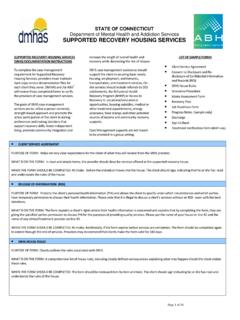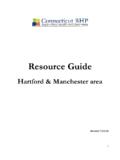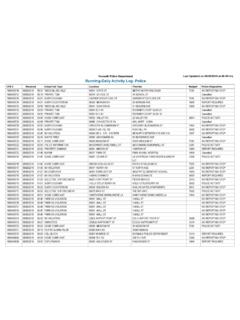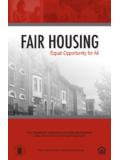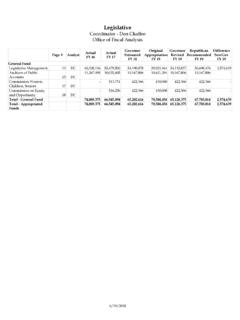Transcription of Directory - Connecticut
1 Prepared by:The Connecticut department Of Social ServicesElderly Services Division25 Sigourney StreetHartford, CT 06106 Patricia A. Wilson-CokerCommissionerMay 2000 TABLE OF CONTENTSI ntroductioniHousing ContractsiiHousing DefinitionsivFinancial-Assistance ProgramsxiHome Care ProgramsxviImportant Facts About The DirectoryxxHousing Communities By RegionSouthwestern Connecticut1 South Central Connecticut17 Eastern Connecticut39 North Central Connecticut66 Western Connecticut102 AppendicesConnecticut s Planning Service AreasState Unit on Aging and Area Agencies on AgingRegional Offices of the Long Term Care OmbudsmenAdult Home Share ProgramsINTRODUCTIONO lder adults and their families routinely request information from the ElderlyServices Division of the department of Social Services (DSS) about elderlyhousing options in Connecticut .
2 Securing the most appropriate housing inrelation to peoples needs is typically a challenge. The Elderly Services Divisionprepared this Directory to help elderly consumers and their families selectappropriate living environments and identify where they are located. Thisdirectory provides a list of communities by housing type and municipality. It alsodescribes different housing options and outlines various programs that can helpelders live independently and stay in their communities. These programs provideboth financial assistance and supportive older individuals age, their living arrangements and availability of supportiveservices become increasingly important considerations. Elderly individuals andtheir families should take the necessary time to research sufficiently availablehousing environments and to prepare adequately for a move to a new contemplating changes in residency, together with those advisingthem, should devote considerable thought to their current and future needs.
3 Acareful analysis of these needs should be made before a crisis develops. Toooften people delay making housing decisions until their health deteriorates to thepoint where they cannot safely stay alone, and their families cannot adequatelycare for them. Postponing these decisions until a crisis develops often reducesindividuals housing options. Persons who are no longer ambulatory or who havecertain health conditions may be restricted in the types of housing communitiesthey can enter. Some communities may have the necessary supportive services,but they may only be available to individuals who already reside in thecommunities. Communities may require that residents be able to maintainthemselves in their units and may not directly admit residents to units thatprovide care.
4 In addition, individuals may select communities that do not haveimmediate openings and may have long waiting lists for choices under the time constraints and emotional stresses that aretypically associated with emergency situations can force individuals into makinghasty decision that may not lead to the best alternatives. Older persons and theirfamily members should begin learning about elderly housing options andsupportive services before there is an actual need for such services. The moreknowledge elderly individuals and their families have when making housingdecisions the greater the likelihood that they will choose a community that is themost appropriate for their current and future needs and who consider changing residency are frequently interested in specificareas of the State; therefore, a regional Directory was prepared for each ofConnecticut s five planning and service areas (PSAs).
5 PSAs divide the state intofive regions; namely, Southwestern, South Central, Eastern, North Central andWestern. PSAs are mandated by the Older Americans Act and are used by theElderly Services Division to coordinate services for the state s elderly citizens. Amap of Connecticut illustrating these areas is shown in Appendix Elderly Services Division attempted to prepare a Directory that was ascomprehensive and accurate as possible. In this effort the Division utilizedmultiple sources of data. The Division asked the Connecticut Housing FinanceAuthority (CHFA) and the Connecticut offices of Housing and UrbanDevelopment (HUD) and Rural Housing Service (RHS) for lists of their elderlyhousing properties. The department of Economic and Community Development(DECD) supplied a list of elderly housing communities associated with theHousing for Elderly Persons program and the Congregate Housing For TheElderly program.
6 Connecticut Independent Congregates (CIC) provided names ofcongregate communities that are members of their organization. Lists of nursinghomes and residential care homes were obtained from the department of PublicHealth s most recent annual report Nursing Home Facilities Licensed by theState of Connecticut 1999-2000. Names of assisted living services agenciesand managed residential communities were also gathered from the Departmentof Public Health s records. The Elderly Services Division also surveyed publichousing authorities, various management companies and each municipality ssocial service department to identify current lists of their age-restrictedcommunities. In addition, the Division investigated real estate sections of localnewspapers and advertisements in magazines specializing in aging issues toascertain names of elderly housing using this Directory should understand that the housing designationsassigned to particular housing complexes were not always identified by staffmembers who represented the communities.
7 Some sources the Division reliedupon for developing the Directory not only supplied names of elderly housingcommunities, but they also categorized them by housing type. Furthermore, theDivision used some discretion in grouping housing communities. If staffmembers associated with any of the communities listed in this Directory wish tomake changes to data related to their properties, they should notify the ElderlyServices Division (see Appendix II). Likewise, the Division would appreciatebeing notified of any available communities that are not listed in the Directory sothat it can better inform elderly consumers of their full range of housing CONTRACTSE lderly individuals may be required to enter into different types of contractsdepending upon the living environment in which they wish to gain residents of most age-restricted communities are offered one type ofcontract; a few, however, are offered a choice.
8 For instance, some communitiesoffer prospective residents the option of buying or renting units. Persons wholive in age-restricted communities generally enter into rental, ownership orcontinuing-care contracts. Nursing homes, on the other hand, requireprospective residents or their guardians to sign admission Contract:Rental contracts usually require leases to be signed between unit owners andresidents. Leases can be on a monthly, yearly or multi-yearly basis. Theseagreements give residents the right to occupy living units for a charge; thischarge is commonly referred to as rent and is generally paid monthly. Leasestypically outline issues that include: a description of the property being rented,the length of time the resident is allowed to live in the unit, the names of theresident and housing provider, the amount of required rent and other fees, thedate rent is due and any late charge requirements in cases when rent is not paidon time, housing management s rules and regulations, resident s rights andresponsibilities, identification of who is responsible for maintenance choresrelated to the unit and building, provisions of utility services and the amount ofsecurity deposit, if any.
9 Before signing leases, residents should carefully reviewthem. Residents should not rely upon management s oral promises regardingservices and housing policies. Residents generally enter into rental contractswhen they reside in certain retirement communities, residential care homes,assisted living communities, congregate housing and communities designated, inthis Directory , as independent Contract:Ownership agreements require that residents purchase their living sign purchase and sales agreements and deeds that give themownership of their homes or living units. Residents are usually responsible forthe maintenance of their units and are typically able to remodel them as theydesire. Unit owners generally pay their own property taxes and are responsiblefor selling their units when they move.
10 Owners of units may gain or lose some oftheir investment depending upon the market value of their units when who hold ownership agreements usually live in condominiums, mobilehome parks or planned communities with single-family Contract:Any person wishing to reserve a living unit or reside in one of Connecticut scontinuing-care retirement communities must enter into a continuing-carecontract. Providers cannot offer or enter into such contracts without beingregistered with the Connecticut department of Social Services. Continuing-carecontracts may also be referred to as residency agreements. The contractrepresents the continuing care provider s long-term commitment to the is a legally binding agreement between the resident and continuing-careprovider that stipulates the specific duties, obligations, rights and privileges ofboth the continuing care community and the resident.










